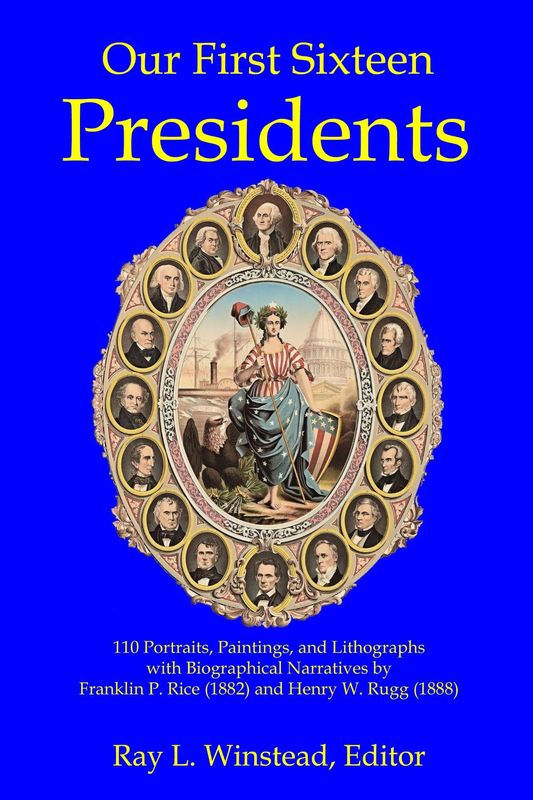
Our First Sixteen
Presidents
110
Portraits, Paintings, and Lithographs
with Biographical Narratives by
Franklin P. Rice (1882) and Henry W. Rugg (1888)
Ray L. Winstead,
Editor
Click an Image for Full Size

Cover Image: Presidents of the United States
Chromolithograph by Francis Bouclet and Augustus Feusier, 1861
Shortcut Down to Contents
Key to
Presidents on Cover Image Below
| 1. George Washington |
5. James Monroe |
| 2. John Adams |
6. John Quincy Adams |
| 3. Thomas Jefferson |
7. Andrew Jackson |
| 4. James Madison |
8. Martin Van Buren |

| 9. William H. Harrison |
13. Millard Fillmore |
| 10. John Tyler |
14. Franklin Pierce |
| 11. James K. Polk |
15. James Buchanan |
| 12. Zachary Taylor |
16. Abraham Lincoln |
Dedication
This book is
dedicated to my wife Dawn
and our two sons Jacob and Daniel.
Ray L. Winstead
Copyright © 2014 Ray L. Winstead
All rights reserved.
Color Edition: ISBN:
149216156X
ISBN-13:
978-1492161561
Black/White Edition: ISBN:
1494410125 ISBN-13: 978-1494410124
PREFACE
This book contains 110 portraits, paintings, and
lithographs of the first sixteen Presidents of the United States, as well as
biographical narratives of the presidents, written by two historians in the
1880s. Images were chosen by the editor from various sources and modified for
this publication, e.g., images have been cropped and “sharpened.” (See the back
of the book for more information about the images.) The editor retyped the
1880s documents to provide versions easier to read but did retain the original
spellings and punctuations. Images of the signatures of the presidents came
from Charles H. Nicoll’s book Our Presidents, from 1788 to 1892 (1892).
The two
authors writing the narratives wrote from two very different perspectives.
Franklin P. Rice, who wrote Portraits and Sketches of the Presidents of the
United States from Washington to Arthur (1882), was very blunt in his brief
analyses, while Henry W. Rugg, who wrote The Presidents of the United States
(1888), wrote longer analyses and was more philosophical. For example, Rice
wrote that “General Jackson possessed but few qualifications for the high office
to which he was elevated. He had no learning and but meagre information. Of
statesmanship he had no conception. His disposition was arbitrary and his
temper ungovernable. But he possessed executive ability, and in an emergency
never hesitated to ‘take the responsibility.’ His integrity and patriotism are
unquestioned. His administration was stormy, inconsistent and undignified in
the extreme.” In contrast, Rugg wrote “When public opinion puts an estimate
upon character it sometimes seems that many noble qualities are left entirely
out of account, just because they lead to actions not in harmony with the
prevailing thought. History presents a broader view with the progress of
civilization, and men like Andrew Jackson are more wisely judged, as their petty
differences of opinion, their minor faults, their lack of culture or attainments
sink into oblivion, while the enduring record of the positive attributes which
made their influence felt upon the destiny of the Nation, grows brighter with
each succeeding year.” The modern reader will also notice the common use of
longer sentences (especially by Henry W. Rugg) and different word choices
commonly used in the nineteenth century, e.g., “removed” to another location,
rather than “moved.”
CONTENTS
1. George Washington
2. John Adams
3. Thomas Jefferson
4. James Madison
5. James Monroe
6. John Quincy Adams
7. Andrew Jackson
8. Martin Van Buren
9. William Henry Harrison
10. John Tyler
11. James K. Polk
12. Zachary Taylor
13 Millard Fillmore
14 Franklin Pierce
15 James Buchanan
16 Abraham Lincoln
About the Images
About the Authors
BUY THE BOOK FROM AMAZON!
Ray L. Winstead


